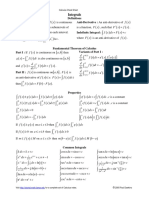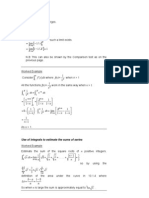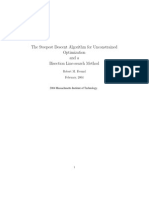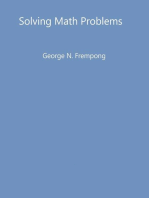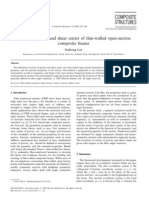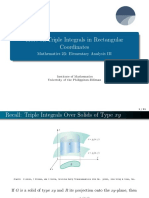Math App
Uploaded by
g3dizeMath App
Uploaded by
g3dizeThis reference is a work in progress.
I have compiled this reference from various sources:
Analytical Mechanics, 7th ed. by Fowles and Cassiday
Wolfram Mathworld
Wikipedia.org
Introduction to Electrodynamics, 3rd ed. by David J. Griths
Any errors or additions please send me an e-mail at i.am.brian.ford@gmail.com
Series Expansions
Taylor Series
A Taylor series is a series expansion of a function about a point. A one-dimensional Taylor
series expansion of a real function f(x) about a point x = a is given by:
f(x) = f(a) + (x a)f
(a) +
(x a)
2
2!
f
(a) +
(x a)
3
3!
f
(3)
(a) + +
(x a)
n
n!
f
(n)
(a)
f(x) =
n=0
(x a)
n
n!
f
(n)
(a)
MacLaurin Series
A MacLaurin series is nothing more than a Taylor series expansion about x = 0:
f(x) = f(0) + (x)f
(0) +
x
2
2!
f
(0) +
x
3
3!
f
(3)
(0) + +
x
n
n!
f
(n)
(0)
where
f
(n)
(x) =
d
n
dx
n
f(x)
Binomial Series
The most general form:
(x + a)
k=0
_
k
_
x
k
a
k
where the binomial coecient is:
_
k
_
=
!
( k)!k!
The series converges for
x
a
< 1.
1 This document was compiled using L
A
T
E
X
Often Used Expansions
e
x
= 1 + x +
x
2
2!
+ =
n=0
x
n
n!
for all x
sin x = x
x
3
3!
+
x
5
5!
=
n=0
(1)
n
(2n + 1)!
x
2n+1
for all x
cos x = 1
x
2
2!
+
x
4
4!
=
n=0
(1)
n
(2n)!
x
2n
for all x
sinh x = x +
x
3
3!
+
x
5
5!
+ =
n=0
x
2n+1
(2n + 1)!
for all x
cosh x = 1 +
x
2
2!
+
x
4
4!
+ =
n=0
x
2n
(2n)!
for all x
ln(1 x) =
n=1
x
n
n
for 1 x < 1
ln(1 + x) =
n=1
(1)
n+1
x
n
n
for 1 < x 1
tan x = x +
x
3
3
+
2
15
x
5
+ for |x| <
2
Complex Exponential
Setting x = i in the expansion for e
x
becomes:
e
i
= 1 + i +
i
2
2
2!
+
i
3
3
3!
+
because i =
1:
i
n
=
_
_
+1 : n = 0, 4, . . .
1 : n = 2, 6, . . .
+i : n = 1, 5, . . .
i : n = 3, 7, . . .
then:
e
i
=
_
1
2
2!
+
4
4!
_
+ i
_
3
3!
+
5
5!
_
= cos + i sin
from the series for cosine and sine.
2 This document was compiled using L
A
T
E
X
Useful Approximations
For small x, the following approximations are often used
e
x
1 + x
sin x x
cos x 1
1
2
x
2
1 + x 1 +
1
2
x
1
1 + x
1 x
1
1 x
1 + x
The last three are based on the binomial series and can be extended for other values of the
exponent:
(1 + x)
n
= 1 + nx +
1
2
n(n 1)x
2
+
Trigonometric Functions
Circular and Hyperbolic Functions
The following relations are useful
cos =
e
i
+ e
i
2
sin =
e
i
e
i
2i
cosh =
e
+ e
2
sinh =
e
2
tanh =
sinh
cosh
=
e
+ e
Relations between Circular and Hyperbolic Functions
sin i = i sinh
cos i = cosh
sinh i = i sin
cosh i = cos
Derivatives
d
d
sin = cos
d
d
sinh = cosh
d
d
cos = sin
d
d
cosh = sinh
3 This document was compiled using L
A
T
E
X
Trigonometric Identities
cos
2
+ sin
2
= 1
1 + tan
2
= sec
2
1 + cot
2
= csc
2
sin( ) = sin cos cos sin
cos( ) = cos cos sin sin
tan( ) =
tan tan
1 tan tan
sin 2 = 2 sin cos
cos 2 = cos
2
sin
2
tan 2 =
2 tan
1 tan
2
sin
2
2
=
1
2
(1 cos )
cos
2
2
=
1
2
(1 + cos )
tan
2
2
=
1 cos
1 + cos
sin + sin = 2 sin
_
+
2
_
cos
_
2
_
cos + cos = 2 cos
_
+
2
_
cos
_
2
_
tan tan =
sin( )
cos cos
Hyperbolic Identities
cosh
2
sinh
2
= 1
tanh
2
+sech
2
= 1
coth
2
csch
2
= 1
sinh( ) = sinh cosh cosh sinh
cosh( ) = cosh cosh sinh sinh
tanh( ) =
tanh tanh
1 tanh tanh
sinh 2 = 2 sinh cosh
cosh 2 = cosh
2
+ sinh
2
tanh 2 =
2 tanh
1 + tanh
2
sinh
2
2
=
1
2
(cosh 1)
cosh
2
2
=
1
2
(cosh + 1)
tanh
2
2
=
cosh 1
cosh + 1
sinh + sinh = 2 sinh
_
+
2
_
cosh
_
2
_
cosh + cosh = 2 cosh
_
+
2
_
cosh
_
2
_
tanh + tanh =
sinh( + )
cosh cosh
The del
Operator
The
operator is a vector dierential operator. Let denote a scalar eld, and
A a vector
eld. Common operations performed with del include
grad()
div(
A)
A
curl(
A)
A
The Laplacian of
The Vector Laplacian of
A
A
The Directional Derivative of
u,
4 This document was compiled using L
A
T
E
X
Cartesian coordinates
Let denote a scalar eld,
A denote a vector eld.
d
l = dx x + dy y + dz z d = dxdy dz
Gradient:
=
x
x +
y
y +
z
z
Divergence:
A =
A
x
x
+
A
y
y
+
A
z
z
Curl:
A =
_
A
z
y
A
y
z
_
x +
_
A
x
z
A
z
x
_
y +
_
A
y
x
A
x
y
_
z
Laplacian:
2
=
2
x
2
+
2
y
2
+
2
z
2
Spherical polar coordinates
Let denote a scalar eld,
A denote a vector eld.
d
l = dr r + r d
+ r sin d
d = r
2
sin dr d d
Gradient:
=
r
r +
1
r
+
1
r sin
Divergence:
A =
1
r
2
r
(r
2
A
r
) +
1
r sin
(sin A
) +
1
r sin
A
Curl:
A =
1
r sin
_
(sin A
)
A
_
r
+
1
r
_
1
sin
A
r
r
(r A
)
_
+
1
r
_
r
(r A
)
A
r
Laplacian:
2
=
1
r
2
r
_
r
2
r
_
+
1
r
2
sin
_
sin
_
+
1
r
2
sin
2
2
5 This document was compiled using L
A
T
E
X
Cylindrical polar coordinates
Let denote a scalar eld,
A denote a vector eld.
d
l = ds s + s d
+ dz z d = s ds ddz
Gradient:
=
s
s +
1
s
+
z
z
Divergence:
A =
1
s
s
(s A
r
) +
1
s
A
+
A
z
z
Curl:
A =
_
1
s
A
z
z
_
s +
_
A
s
z
A
z
s
_
+
1
s
_
s
(s A
)
A
s
_
z
Laplacian:
2
=
1
s
s
_
s
s
_
+
1
s
2
2
+
2
z
2
Conversions between coordinate systems
Spherical and Cartesian
x = r sin cos
y = r sin sin
z = r cos
r =
_
x
2
+ y
2
+ z
2
= tan
1
_
_
x
2
+ y
2
z
_
= tan
1
_
y
z
_
x = sin cos r + cos cos
sin
y = sin sin r + cos sin
+ cos
z = cos r sin
r = sin cos x + sin sin y + cos z
= cos cos x + cos sin y sin z
= sin x + cos y
Cylindrical and Cartesian
x = s cos
y = s sin
z = z
s =
_
x
2
+ y
2
= tan
1
_
y
x
_
z = z
x = cos s sin
y = sin s + cos
z = z
s = cos x + sin y
= sin x + cos y
z = z
6 This document was compiled using L
A
T
E
X
Vector Identities
Triple Products
Let
A,
B,
C be vector elds.
A (
B
C) =
B (
C
A) =
C (
B) (1)
A(
B
C) =
B(
A
C)
C(
B) (2)
Product Rules
Let and be scalar elds.
() = (
) + (
) (3)
B) =
A(
B) +
B(
A) + (
A
)
B+ (
B
)
A (4)
(
A) = (
A) +
A (
) (5)
B) =
B (
A)
A (
B) (6)
(
A) = (
A)
A(
) (7)
B) = (
B
)
A(
A
)
B+
A(
B)
B(
A) (8)
Second Derivatives
A) = 0 (9)
) = 0 (10)
A) =
(
A)
2
A Vector Laplacian (11)
Fundamental Theorems
Note that d is a dierential element of volume, da is a dierential element of area as a vector,
and d
l is a dierential element of length as a vector.
Fundamental Theorem for Path Integrals
(Path Independence, Gradient Theorem):
_
b
a
(
) d
l = (
b) (a)
Divergence Theorem (Gauss Theorem):
_
V
(
A) d =
_
S
A da
Stokes Theorem (Circulation, Curl Theorem):
_
S
(
A) da =
_
C
A d
l
7 This document was compiled using L
A
T
E
X
You might also like
- Microsoft Word - Calculus 2 Formula Cheat Sheet83% (6)Microsoft Word - Calculus 2 Formula Cheat Sheet2 pages
- Gu Ia de Problemas de La Secci On 2.5 Del Libro Mathematical Methods For Physicists, Sixth Edition, de George ArfkenNo ratings yetGu Ia de Problemas de La Secci On 2.5 Del Libro Mathematical Methods For Physicists, Sixth Edition, de George Arfken8 pages
- Intermediate Calculus Study Sheet (MATH 262)No ratings yetIntermediate Calculus Study Sheet (MATH 262)0 pages
- Calculus Review and Formulas: 1 FunctionsNo ratings yetCalculus Review and Formulas: 1 Functions11 pages
- Trigonometric Identities: Formula Sheet Ee2Fh3No ratings yetTrigonometric Identities: Formula Sheet Ee2Fh34 pages
- MTH 253 Calculus (Other Topics) : Chapter 10 - Section 10.0No ratings yetMTH 253 Calculus (Other Topics) : Chapter 10 - Section 10.0142 pages
- Niu Physics PHD Candidacy Exam - Standard Formula SheetNo ratings yetNiu Physics PHD Candidacy Exam - Standard Formula Sheet3 pages
- Solutions To Problems in Quantum Field Theory100% (2)Solutions To Problems in Quantum Field Theory7 pages
- Lesson 12 - Derivative of Inverse Trigonometric FunctionsNo ratings yetLesson 12 - Derivative of Inverse Trigonometric Functions12 pages
- Name: Talha Jabbar S/O Abdul Jabbar Roll No: Fa-20-Bsse-196 Section: BNo ratings yetName: Talha Jabbar S/O Abdul Jabbar Roll No: Fa-20-Bsse-196 Section: B16 pages
- Trigonometric Ratios to Transformations (Trigonometry) Mathematics E-Book For Public ExamsFrom EverandTrigonometric Ratios to Transformations (Trigonometry) Mathematics E-Book For Public Exams5/5 (1)
- Mathematics 1St First Order Linear Differential Equations 2Nd Second Order Linear Differential Equations Laplace Fourier Bessel MathematicsFrom EverandMathematics 1St First Order Linear Differential Equations 2Nd Second Order Linear Differential Equations Laplace Fourier Bessel MathematicsNo ratings yet
- Applications of Derivatives Errors and Approximation (Calculus) Mathematics Question BankFrom EverandApplications of Derivatives Errors and Approximation (Calculus) Mathematics Question BankNo ratings yet
- Factoring and Algebra - A Selection of Classic Mathematical Articles Containing Examples and Exercises on the Subject of Algebra (Mathematics Series)From EverandFactoring and Algebra - A Selection of Classic Mathematical Articles Containing Examples and Exercises on the Subject of Algebra (Mathematics Series)No ratings yet
- De Moiver's Theorem (Trigonometry) Mathematics Question BankFrom EverandDe Moiver's Theorem (Trigonometry) Mathematics Question BankNo ratings yet
- Test 1 Questions: Pancakes Amount of Amount of Mix WaterNo ratings yetTest 1 Questions: Pancakes Amount of Amount of Mix Water4 pages
- Phenomenography - Describing Conceptions of The World Around Us100% (1)Phenomenography - Describing Conceptions of The World Around Us24 pages
- Center of Gravity and Shear Center of Thin-Walled Open-Section Composite Beams100% (1)Center of Gravity and Shear Center of Thin-Walled Open-Section Composite Beams6 pages
- A Spatial Version of Octoidal Gears Via The Generalized Camus TheoremNo ratings yetA Spatial Version of Octoidal Gears Via The Generalized Camus Theorem13 pages
- Physics: Kinematics: Motion in Two DirectionNo ratings yetPhysics: Kinematics: Motion in Two Direction16 pages
- Math 23 Lecture 3.2 More On Triple Integrals PDFNo ratings yetMath 23 Lecture 3.2 More On Triple Integrals PDF19 pages
- Answer All Questions.: 1 The Relation Between Set A and Set B Is Defined by A Set of Ordered Pairs100% (1)Answer All Questions.: 1 The Relation Between Set A and Set B Is Defined by A Set of Ordered Pairs12 pages
- Navigation-2: (Terrestrial and Coastal Navigation-2)67% (3)Navigation-2: (Terrestrial and Coastal Navigation-2)3 pages
- Soccer Coordinates Differentiated Activity SheetsNo ratings yetSoccer Coordinates Differentiated Activity Sheets6 pages
- Math Olympiad Problems Collection v2 PDFNo ratings yetMath Olympiad Problems Collection v2 PDF144 pages
- The Poisson Bracket and Magnetic Monopoles PDFNo ratings yetThe Poisson Bracket and Magnetic Monopoles PDF9 pages
- Gu Ia de Problemas de La Secci On 2.5 Del Libro Mathematical Methods For Physicists, Sixth Edition, de George ArfkenGu Ia de Problemas de La Secci On 2.5 Del Libro Mathematical Methods For Physicists, Sixth Edition, de George Arfken
- MTH 253 Calculus (Other Topics) : Chapter 10 - Section 10.0MTH 253 Calculus (Other Topics) : Chapter 10 - Section 10.0
- Niu Physics PHD Candidacy Exam - Standard Formula SheetNiu Physics PHD Candidacy Exam - Standard Formula Sheet
- Lesson 12 - Derivative of Inverse Trigonometric FunctionsLesson 12 - Derivative of Inverse Trigonometric Functions
- Name: Talha Jabbar S/O Abdul Jabbar Roll No: Fa-20-Bsse-196 Section: BName: Talha Jabbar S/O Abdul Jabbar Roll No: Fa-20-Bsse-196 Section: B
- Shortcuts to College Calculus Refreshment KitFrom EverandShortcuts to College Calculus Refreshment Kit
- Trigonometric Ratios to Transformations (Trigonometry) Mathematics E-Book For Public ExamsFrom EverandTrigonometric Ratios to Transformations (Trigonometry) Mathematics E-Book For Public Exams
- A-level Maths Revision: Cheeky Revision ShortcutsFrom EverandA-level Maths Revision: Cheeky Revision Shortcuts
- Mathematics 1St First Order Linear Differential Equations 2Nd Second Order Linear Differential Equations Laplace Fourier Bessel MathematicsFrom EverandMathematics 1St First Order Linear Differential Equations 2Nd Second Order Linear Differential Equations Laplace Fourier Bessel Mathematics
- Applications of Derivatives Errors and Approximation (Calculus) Mathematics Question BankFrom EverandApplications of Derivatives Errors and Approximation (Calculus) Mathematics Question Bank
- Factoring and Algebra - A Selection of Classic Mathematical Articles Containing Examples and Exercises on the Subject of Algebra (Mathematics Series)From EverandFactoring and Algebra - A Selection of Classic Mathematical Articles Containing Examples and Exercises on the Subject of Algebra (Mathematics Series)
- Differentiation (Calculus) Mathematics Question BankFrom EverandDifferentiation (Calculus) Mathematics Question Bank
- De Moiver's Theorem (Trigonometry) Mathematics Question BankFrom EverandDe Moiver's Theorem (Trigonometry) Mathematics Question Bank
- Test 1 Questions: Pancakes Amount of Amount of Mix WaterTest 1 Questions: Pancakes Amount of Amount of Mix Water
- Phenomenography - Describing Conceptions of The World Around UsPhenomenography - Describing Conceptions of The World Around Us
- Center of Gravity and Shear Center of Thin-Walled Open-Section Composite BeamsCenter of Gravity and Shear Center of Thin-Walled Open-Section Composite Beams
- A Spatial Version of Octoidal Gears Via The Generalized Camus TheoremA Spatial Version of Octoidal Gears Via The Generalized Camus Theorem
- Answer All Questions.: 1 The Relation Between Set A and Set B Is Defined by A Set of Ordered PairsAnswer All Questions.: 1 The Relation Between Set A and Set B Is Defined by A Set of Ordered Pairs
- Navigation-2: (Terrestrial and Coastal Navigation-2)Navigation-2: (Terrestrial and Coastal Navigation-2)

